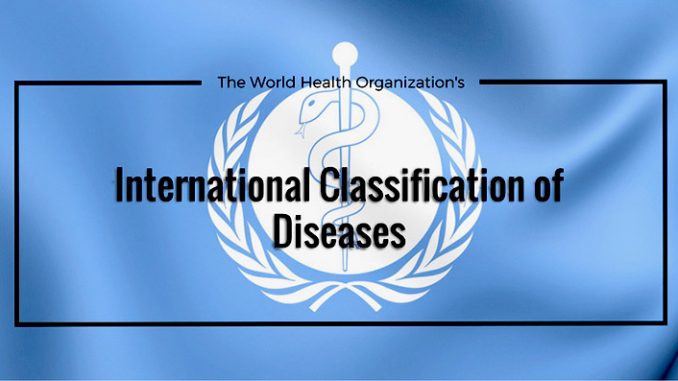
Table of Contents
What is ICD (International Classification of Diseases)?
- ICD (International Statistical Classification of Diseases and Related Health Problems), shortly known as International Classification of Diseases is the base/foundation for the identification of health trends and statistics.
- ICD is an international uniform standard for reporting diseases and health conditions.
- It is the diagnostic classification standard for all clinical and research purposes.
- ICD maps the human health condition from birth to death. No matter, however we die of, it will be recorded/coded under ICD.
- ICD is a global base, where the global health movements are recorded by following the international standards, in company with the numerical analysis tools and techniques for broadcasting and recording the disease patterns along with the well-being of the people.
- ICD incorporates different factors influencing health, including external causes of morbidity and mortality.
- ICD defines the various patterns of infectious, communicable, and non-communicable diseases followed by disorders, injuries and numerous health disability in a systematic way, which helped in the uprising of following points:
- Accessible health information that acts as a benchmark for planning health strategies.
- Easy storing, retrieval and investigation of health statistics for evidenced based decision-making and accountability.
- Exchange of health information between hospitals, institutions, nations, and different development regions.
- Relate data within the same areas across different periods.
- Developing international guideline and strategies to bring down the high prevalence and incidence rate, mortality rate, death rate of vulnerable diseases.
- Determining the risk factors that have negative impacts on health.
- Abundant use of monitoring and supervision skills in various field of health science in the identification of diseases in respect to their severity and detrimental to health.
- ICD also helps in resource allocation.
Different Versions of ICD:
- The history of ICD dates back to the 16th century.
- In 1893, International Statistical Institute adopted the first international classification edition which is also known as the International List of Causes of Death.
- The international statistical institute implemented the International List of Causes of Death, also known by the name of First International Classification, in 1893.
- ICD has a different version from first until ICD-11.
- The first version of International Statistical Classification of Diseases, Injuries and Causes of Death (ICD) was produced in 1940.
- WHO published the 6th version of ICD i.e. ICD-6 in 1948, which included morbidity for the 1st
- WHO has also stated clearly to its member states to use the latest version of ICD for morbidity and mortality statistics.
- Since then, ICD has been revised and published in a series of editions to reflect advances in health and medical science over time.
- Currently, ICD-10 is in practice. It was endorsed in 1990 by 43rd World Health Assembly (WHA).
- In near future, ICD-11 will be in practice. ICD-11 was recently released on 18 June 2018. However, reporting using ICD-11 will only start from 1 January 2022.
- This lag time for implementing ICD-11 is to allow member states to prepare for implementation and translate ICD into their national languages.
Idea and Need for Classification in ICD:
Classification or Sorting of disease is needed due to the following facts:
- Determines the natural cause of the disease mechanism in a human body.
- Determines the exact problem and solution of the disease.
- Determines the normal stages and the critical stage of the disease
- Formulation of health statistics. ICD is the bedrock for health statistics.
- Concludes the risk factors of the illness.
- Calculates the prevalence and incidence rate, which ultimately helps to develop mitigating measures against the disease.
- Helps to categorize vulnerable disease.
- Determines the health cost and resources required to combat disease.
- Critical analysis of the disease based on the severity.
General Principles of Disease Classification:
- A statistical classification of diseases must be confined to a limited number of mutually exclusive categories.
- The categories have to be chosen to facilitate the statistical study of disease phenomena.
- A specific disease entity that is of particular public health importance or that occurs frequently should have its own category.
- Every disease or morbid condition must have a well-defined place in the list of categories.
- A statistical classification of diseases should retain the ability both to identify specific disease entities and to allow statistical presentation of data for broader groups, to enable useful and understandable information to be obtained.
Principles of classification of ICD:
The ICD is a variable-axis classification. The structure of ICD structure was developed of that proposed by William Farr during early days of international discussions. According to him, for all practical, epidemiological purposes, statistical data on diseases should be grouped in the following way:
- epidemic diseases
- constitutional or general diseases
- local diseases arranged by site
- developmental diseases
- injuries
How are Diseases Classified in ICD?
The diseases are categorized:
| On the basis of | Disease |
| Body system or region | Abdominal disease
Gastrointestinal disease |
| Anatomic | Lung disease
Liver disease |
| Function | Metabolic disease |
| Pathological/ nature of the disease process | Inflammatory disease
Tumors formation |
| Etiologic/ cause | Bacterial infection |
| Epidemiology | Epidemic disease |
| Statistical | High prevalence and incidence rate disease. |
Advantages and Limitations of ICD:

Advantages:
a) Effective communication
- The member states adopted ICD many years ago which has served as a medium to support ideas, early detection of disease, and update the rest of the world about the global phenomena.
b) Provision of concise and realistic data
- ICD has numerous versions every year but ICD 10 codes has to facilitate the accessibility of data in an effective manner, which provide to serve the patients in a better way.
c) Precision
- ICD prolific code i.e. ICD- 10 benefitted in early detection of fraud and increased the accuracy. Likewise, works to determine coverage on a domestic and international level.
d) Performance Monitoring
- The elevation to ICD-10 will improve a benefactor’s capability to monitor services and resource utilization, scrutinize healthcare costs, monitor outcomes, and measure performance. More pressure on detailed procedure types will agree with providers to estimate their own performance as compared to their friends, and take the obligatory steps towards enhancement.
e) Setting Health Policy
- Ever since the ICD-10 code set is widely used all around the world. However, health officials can practice the data to compare public health trends with global pandemics. Perhaps, this might help in implementing enhanced health policies across the world.
f) ICD helps to plan, prioritize and allocate health resources as per the necessity and demand.
g) ICD provides a global common vocabulary for recording, reporting and monitoring health problems.
Limitations:
a) Reimbursement:
- In support of the member states, ICD- 10 emphasizes early detection of fraud and inequality but in the long run, none of the countries utilize that ICD-10 codes, when the matter is about compensating physicians and health staffs.
b) Escalation of code:
- The rapid growth of ICD codes has made people puzzled, as there are; intense variations and many people are unaware of all codes due to the formulation of excessive codes in every interval.
c) Denials:
- The cost-saving measures with ICD-10 have a provision of paying less to a health provider. Therefore, it can lead to physicians spending more time on coding, and eventually less time on actually being paid.
References and For More Information:
https://www.who.int/health-topics/international-classification-of-diseases
https://www.who.int/classifications/icd/en/
https://www.britannica.com/science/human-disease/Classifications-of-diseases
https://icd.who.int/browse10/Content/statichtml/ICD10Volume2_en_2016.pdf
https://www.who.int/classifications/icd/ICD10Volume2_en_2010.pdf
https://www.who.int/health-topics/international-classification-of-diseases
https://greengarageblog.org/7-pros-and-cons-of-icd-10
https://www.flatworldsolutions.com/healthcare/articles/icd-10-implementation-benefits.php
https://searchhealthit.techtarget.com/definition/ICD-10
https://www.who.int/classifications/icd/en/